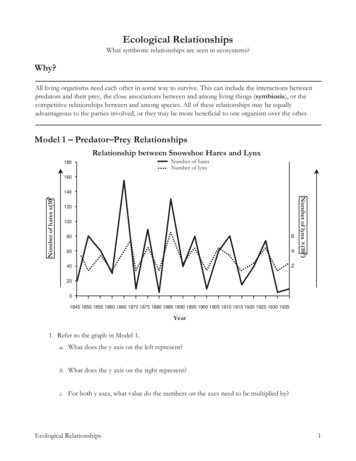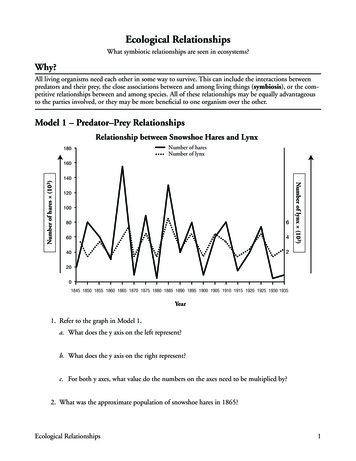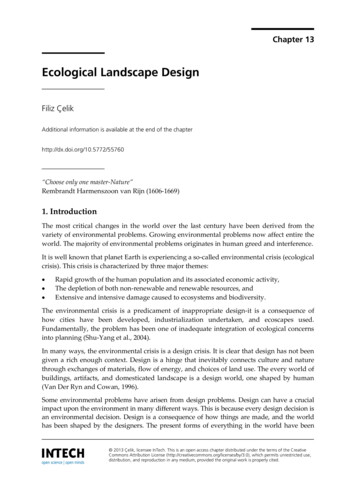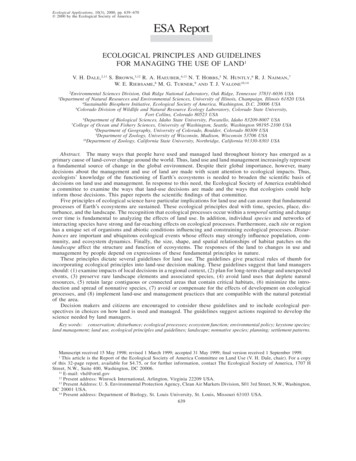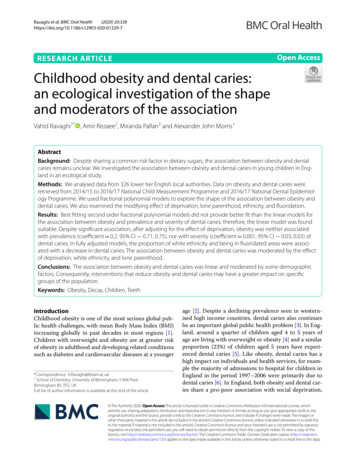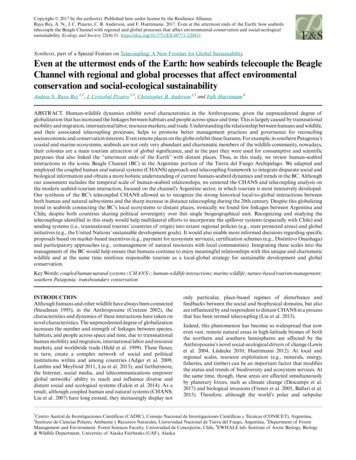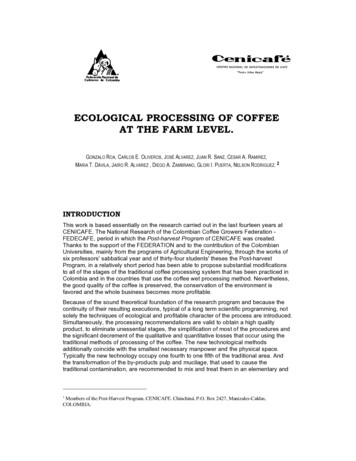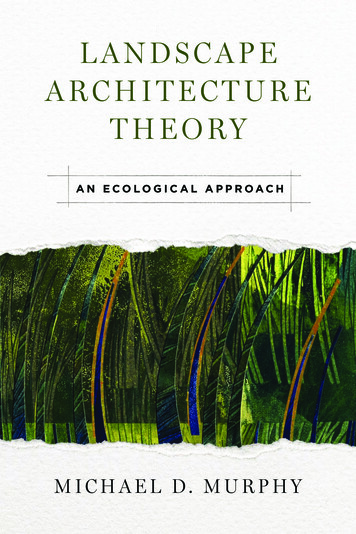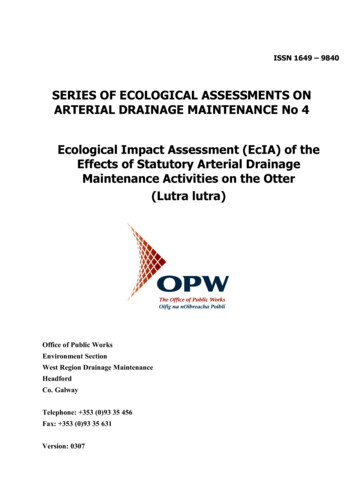
Transcription
ISSN 1649 – 9840SERIES OF ECOLOGICAL ASSESSMENTS ONARTERIAL DRAINAGE MAINTENANCE No 4Ecological Impact Assessment (EcIA) of theEffects of Statutory Arterial DrainageMaintenance Activities on the Otter(Lutra lutra)Office of Public WorksEnvironment SectionWest Region Drainage MaintenanceHeadfordCo. GalwayTelephone: 353 (0)93 35 456Fax: 353 (0)93 35 631Version: 0307
DISCLAIMERNo part of this publication should be taken as a statement of Office of PublicWorks policy. The views expressed by the author(s) are not necessarily thoseof the Office of Public Works. The user of this report assumes fullresponsibility for any policy decisions and for any action taken as a result ofany conclusions contained herein. Neither the Office of Public Works, nor theauthor(s) may be held liable for the outcome of any policy decision or actiontaken by the users of this publication.
ForewordThis Ecological Impact Assessment follows on from the strategic approach outlined in“Series of Ecological Assessment on Arterial Drainage Maintenance No. 1:Screening of NATURA 2000 Sites for Impacts of Arterial Drainage MaintenanceOperations.”It examines the impacts of statutory arterial drainage maintenance activities on theotter (Lutra lutra), outlines measures to mitigate any negative impacts, and possibleenhancement opportunities.Environment Section
The Office of Public WorksEcIA Of the Effects of Statutory Arterial Drainage Maintenance Activities on the Otter (Lutra lutra)November 2006The Office of Public WorksEcological Impact Assessment(EcIA) of the Effects of StatutoryArterial Drainage MaintenanceActivities on the Otter (Lutra lutra)November 2006EnviroCentreCraighall Business ParkEagle StreetGlasgowG4 9XAProject DirectorDr Peter CosgroveProject ManagerRichard McMullant 0141 341 5040f 0141 341 5045w www.envirocentre.co.uke avenReport No: 2514DaresburyStatus: FinalProject No : 20326JCopy No :01Rev. No :00i
The Office of Public WorksEcIA Of the Effects of Statutory Arterial Drainage Maintenance Activities on the Otter (Lutra lutra)November 2006Table of Contents1.REMIT. 22.EXECUTIVE SUMMARY . 33.INTRODUCTION. 43.1Historical Background and Functions of Statutory Arterial Drainage.43.2Legal and Policy Context for this Ecological Impact Assessment.43.3Objective and Scope of Study.53.4Methodology.64.SPECIAL AREAS OF CONSERVATION . 84.1Description of the Conservation Aspect.84.2Site Evaluations.94.3Site Integrity.114.4Other or Linked Environmentally Sensitive Aspects .125.MAINTENANCE ACTIVITIES CARRIED OUT BY THE OPW. 145.1Outline of Maintenance Activities.145.2Extent of Interference.165.3Duration and Timing of Maintenance Activities .175.4Impacts on Sensitive Aspects .176.EFFECTS OF THE MAINTENANCE OPERATIONS. 186.1Impact Assessment .186.2Changes in Site Integrity.216.3River Corridor Upstream, On Site and Downstream .217.MITIGATION MEASURES. 227.1Avoidance Measures .227.2Influence of EDM Work Practices .247.3Specific Extra Mitigation Measures Identified.257.4Opportunities for Enhancement or Compensatory Measures.258.CONCLUSION AND SUMMARY. 288.1Level of Significance of the Likely Impact.288.2Likely Success of Proposed Mitigating and Enhancement Measures.288.3Information Relevant to Future Biodiversity and Heritage Impact Assessments.28ii
The Office of Public WorksEcIA Of the Effects of Statutory Arterial Drainage Maintenance Activities on the Otter (Lutra lutra)November 2006AppendicesAppendix AAppendix BAppendix CMapsField SurveysReferencesList of FiguresFigure 1: OPW Channel (C1/21/1/5/18/3) Looking Upstream.35Figure 2: OPW Channel (CM5/10) Looking Upstream.37Figure 3: OPW Channel (C1) Looking Downstream.39Figure 4: OPW Channel (C1/21) Facing Downstream .41List of TablesTable 1: Assessment Sites .6Table 2: Other and Linked Sensitive Aspects .13Table 3: Maintenance Activity Timing .17Table 4: Potential Impacts, Mitigation and Residual Significance .29iii
The Office of Public WorksEcIA Of the Effects of Statutory Arterial Drainage Maintenance Activities on the Otter (Lutra lutra)November 2006GLOSSARYBiodiversityConnectivityCouchThe diversity of all life; faunal and floral.CrepuscularCubsRefers to an animal which is mainly active during dawn and dusk hoursDurationEcological ImpactAssessment (EcIA)An Impact Assessment term; refers to the length of time an impact may last.EcosystemEnhancementThe flora and fauna within a given area and how they interact with each other.How habitats are linked to one another to provide routes of travel for wildlife.An above ground resting place for otterJuvenile otters.The formal process by which potential impacts on ecological factors are assessed as totheir significance.With reference to habitat, enhancement describes the improvement in terms of extent andspecies richness.European SitesExtentFragmentationSites identified for protection under the EU Habitats and Birds Directive.FrequencyGlidesAn Impact Assessment term, refers to how often an impact may occur.HoltAn underground resting place of otters. Normally within tree roots immediately on theAn Impact Assessment term, refers to the area over which an impact may occur.A term given to the isolation of habitat by removal of vegetation.A 2-3cm sub-surface water movement.bank.ImpactAn effect on an ecological feature.IntegrityKeystone SpeciesThe sustainability or wholeness of a site or feature.A species whose inclusion in an ecosystem has a major effect other species and habitatspresent.Lay-upLinkedAn above ground resting place of otter.With reference to habitats or species, linked reflects a relationship between the subjectspecies and a further species.MagnitudeMeta-populationMustelidaeAn Impact Assessment term, refers to size or amount of an impact.Natal DensNational Parks andWildlife Service(NPWS)Natura 2000 Network.A holt used by otters to rear young.PathProbabilityRefugesAn entrance to a water body used by otters.ReversibilityRifflesSeveranceAn Impact Assessment term, refers to whether an impact may be undone.SignificanceAn Impact Assessment term, refers to whether an impact will have a large enough effectA group of discrete populations which may interact with each other.A taxonomic grouping to which otters belong.The statutory nature conservation organisation in Ireland.Refers to the collection of European designated sites; SACs and SPAs.An Impact Assessment term, refers to the likelihood that an impact may occur.Places where animals may shelter.A water movement which breaks the surface.The process by which fragmentation of habitat occurs.to require mitigation.SlideAn entrance to a water body used by otters.Special Area ofConservation (SAC)Special Protected Area(SPA)SpraintA designation under the EU Habitat Directive. A constituent of The Natura 2000 Network.Sprainting SiteTracksA prominent feature used by otters for sprainting e.g. an in-stream boulderA designation under the EU Birds Directive. A constituent of The Natura 2000 Network.Otter faeces. Used by otter to mark territories and to communicate with each other.Diagnostic footprints of otters.1
The Office of Public WorksEcIA Of the Effects of Statutory Arterial Drainage Maintenance Activities on the Otter (Lutra lutra)1.November 2006REMITThis report was commissioned by the Office of Public Works, on the 13th June 2006, withrespect to an Ecological Impact Assessment (EcIA) on the effects of statutory Arterial DrainageMaintenance activities on the European Otter (Lutra lutra) in Ireland.The aim of the EcIA was to assess the potential impacts, both positive and negative, of thestatutory Arterial Drainage Maintenance activities on the otter. The otter is a qualifying interestof 14 Special Areas of Conservation (SACs) in Ireland, within which Maintenance Activities areundertaken.The aim has been achieved through the following objectives; Case studies of four representative SAC systems, including species surveys;Identification and research of maintenance activities; andImpact Assessment following Institute of Ecology and Environmental Management(IEEM) guidelines for Ecological Impact Assessment (2006)1.1Institute of Ecology and Environmental Management. Guidelines for Ecological Impact Assessment in the UnitedKingdom (IEEM 2006).2
The Office of Public WorksEcIA Of the Effects of Statutory Arterial Drainage Maintenance Activities on the Otter (Lutra lutra)2.November 2006EXECUTIVE SUMMARYThe EcIA, of impacts from Arterial Drainage Maintenance activities, on the otter, was basedupon consultation with relevant parties, site visits, species surveys, and interpretation ofmaintenance activities, within four representative SAC systems.Predictive assessments were then applied to the baseline conditions recorded, potential impactsidentified, mitigation measures proposed as appropriate, and residual impacts assessed.The application of field work identified; site use by otters, maintenance activities and potentialimpacts.The potential impacts were identified and assessed as follows: Direct Habitat Loss; Severance; Loss of Life; Physical disturbance ; Noise disturbance; andHabitat creation.All were assessed against guidance offered by IEEM.Mitigation suggested to address these impacts included: Establish a clear understanding on the needs of otters and the relevance of differentmaintenance activities upon those needs; Training of front-line staff in the identification of otter field signs and resting places, oruse specially trained professional consultants; Ongoing surveys to investigate site use by otters and monitor potential recovery timefrom maintenance activities;Adhere, develop and regularly assess the Environmental Drainage Maintenance (EDM)work practices;Where possible, mature trees and in-stream boulders should be retained;No use of heavy plant and use smaller work parties, where otters are known to besheltering (informed by survey work);Regular communication with relevant nature conservation organisations, fisheriesboards and rangers; and For future design, construction and maintenance of small bridges and culverts refer tothe Design Manual for Roads and Bridges (DMRB).Using IEEM guidelines an assessment was carried out of the potential impacts frommaintenance activities on otters. The assessment concluded that the overall impact from themaintenance activities can be judged to range from a low significant impact (severance,physical disturbance and noise disturbance) to a significant positive impact (habitat creation).3
The Office of Public WorksEcIA Of the Effects of Statutory Arterial Drainage Maintenance Activities on the Otter (Lutra lutra)November 20063.INTRODUCTION3.1Historical Background and Functions of Statutory Arterial Drainage.3.1.1 Historical BackgroundDrainage works have a long history in Ireland stretching back to the mid 19th century. Irelandby nature is liable to flooding and drainage problems principally due to the fact that the countryhas high rainfall, and a relatively low-lying interior surrounded by coastal highlands.A large scale programme of catchment wide Arterial Drainage Schemes was carried out by theState between 1945 and 1995, and, following the 1995 Amendment to the 1945 ArterialDrainage Act, a number of flood relief schemes have been undertaken to mitigate, in the main,urban flooding.There is a statutory obligation on the State to maintain these schemes “in proper repair andeffective condition”. The State exercises this responsibility through the Office of Public Works(OPW) which is now the State’s Lead Agency in relation to flood management.In recent years the OPW has become aware of the effects of its activities on the naturalenvironment. The OPW recognises the need to fully understand the impacts of drainagemaintenance operations with the aim of both minimising negative impacts and focusingthrough studies and research on identifying future positive impacts (OPW 2006).3.1.2 Functions of Statutory Arterial DrainageThe main functions of the Statutory Arterial Drainage Schemes are to provide flood alleviation(freshwater and estuarine) and outfall for land drainage.In total over 260,000 hectares of land has benefited from the 1945 Arterial Drainage Actschemes (OPW 2006).3.2Legal and Policy Context for this Ecological Impact AssessmentTo ensure compliance with the EC Habitats Directive (Council Directive 92/43/EEC), transposedinto Irish law through the European (Natural Habitat) Regulations (1997), the OPW is requiredto carry out environmental assessments for European Sites (Natura 2000 network), whichoverlap with drainage operations. European Sites under the Habitats Directive include SpecialAreas of Conservation (SACs) and Special Protected Areas (SPAs).In accordance with Section 31 of the European Communities (Natural Habitat) Regulations1997, where an operation or activity is carried out by the State that is likely to have asignificant effect on a European Site, an appropriate assessment should be carried out on theimplications for that site, in view of its conservation objectives. The operation or activity shallonly be undertaken when it is ascertained that it will not adversely affect the integrity of thesite and then, having regard to conclusions from the assessment (OPW 2006).4
The Office of Public WorksEcIA Of the Effects of Statutory Arterial Drainage Maintenance Activities on the Otter (Lutra lutra)November 2006This assessment addresses those potential impacts which may affect otters in the sitesinvestigated.It is important to note that the designation process of SACs and SPAs commenced in Irelandafter the Arterial Drainage Schemes. The designation process commenced in the mid 1990’sand 1980’s respectively and the national programmes of Arterial Drainage Schemescommenced in 1948 and finished in 1995. Therefore, all Natura designations are based onconservation factors in a post drainage scheme environment (OPW 2006).3.3Objective and Scope of StudyThis study has been designed to assess the potential impacts of Arterial Drainage Maintenanceactivities on the otter. As such, the scope of the study has necessarily included anunderstanding and, where possible, an observation of all activities associated withmaintenance. These activities are discussed further in Chapter 5 of this report.Furthermore, as this study aims to address impacts at a national scale, the scope of studyincludes a geographical element in ensuring that samples have been taken across the country(4 catchments maintained by OPW).During the development of the scope of study, an understanding of the volume of datarequired was addressed. It was considered by the OPW, that a representative selection ofstudy areas, or case studies, would provide sufficient data. The rationale behind this included; That maintenance activities across the country are standardised;That complete studies of each SAC and associated drainage channels and tributarieswould be extremely time-consuming and costly; and That the data gathered and EcIAs produced through complete surveys of each SAC,their drainage channels and tributaries would quickly become dated and irrelevantgiven that maintenance works is often carried out at intervals of up to a decade.This understanding led to a scope of study which included an assessment of 4 representativeSAC systems based on geographical location and maintenance activities currently beingundertaken.The selected SACs are detailed in Table 1, and are illustrated in Maps 1-5 in Appendix A of thisreport. Map 1 shows the SAC locations. Maps 2-5 show SAC boundaries, OPW schemechannels, site layout and field signs recorded during each survey.5
The Office of Public WorksEcIA Of the Effects of Statutory Arterial Drainage Maintenance Activities on the Otter (Lutra lutra)November 2006Table 1: Assessment SitesSiteRegionSAC/CodeOPW ChannelGrid ReferenceReference3.41West2WestRiver Moy SAC (OO2298)Lough Carra/Mask SAC (001774)3South-West4EastLower River Shannon SAC (002165) - MulkearRiverRiver Boyne and River Blackwater SAC (002299) Athboy RiverC1/21/1/5/18/3M26121 77747CM5/10M20006 73803C1C1/21R78710 49075072864 62917Methodology3.4.1 Field WorkAs part of this study, surveys were undertaken within each case study area. Surveys were,where possible, undertaken while maintenance activities were underway. So as to provide aclearer understanding of site use by otters, surveys were also undertaken on sites wheremaintenance had recently taken place or was due to begin.Surveys were undertaken in bright, dry conditions between the 19th & 20th of September and10th & 11th of October 2006. Each survey took place following a sustained period of dryweather. This is an important aspect of otter surveying as heavy rain and high water levels oftenremove the field signs searched for, and can potentially produce false-negative results.Surveying involved walking within the 4 representative SACs/OPW channels (C1/21/1/5/18/3,CM5/10, C1 and C1/21), and searching for field signs of otter. Searching for field evidence wasextended to 1km in length and 5-10m either side of each watercourse, and through adjacentland zones.Each survey followed methodology endorsed by NPWS and evidence searched for included: Spraints - Otter faeces/droppings used as territorial signposts. Often located inprominent positions and can be placed on deliberate piles of river soil or sand; Tracks - Diagnostic, five-toed track; Feeding remains - Can often be a useful indication of otter presence; Paths/Slides - Otter can often leave a distinctive path from and into the watercourse; Holts - Holts (underground shelter) are generally found:o Within trees roots at the edge of the bank of a river;o Within hollowed out trees;o In naturally formed holes in the river banks that can be easily extended;o Or preferably in ready-made holes created by other large mammals or humanssuch as Badgers setts, rabbit burrows or pipes; and Couches/lay-ups: Couches or lay-ups are places for lying up above ground are usuallylocated near a watercourse, between rocks or boulders, under dense vegetation.The main focus of survey in this case was placed on the presence of spraints, potential couches(as male otters rarely use holts), and actual or potential holts. This was primarily related to the6
The Office of Public WorksEcIA Of the Effects of Statutory Arterial Drainage Maintenance Activities on the Otter (Lutra lutra)November 2006fact that spraints are a good way of telling whether there is fresh evidence of otter presence inthe local area. Couches are used as places of shelter and holts are particularly important asmaternity sites (and can be used for this purpose throughout the year).In order to provide a complete understanding of the ecology of the site, the habitats in thevicinity of each survey area were also recorded.As discussed field signs recorded during each survey are illustrated in Maps 2-5 in Appendix A,and full survey results, along with detailed habitat descriptions, are presented in Appendix B.3.4.2 Assessment MethodologyThe assessment has been undertaken following the guidelines produced by the Institute ofEcology and Environmental Management as described in the Remit section of this report. TheseGuidelines reflect current legislation and best practice relating to EcIA and species protection.7
The Office of Public WorksEcIA Of the Effects of Statutory Arterial Drainage Maintenance Activities on the Otter (Lutra lutra)4.SPECIAL AREAS OF CONSERVATION4.1Description of the Conservation AspectNovember 20064.1.1 Biology and EcologyThe otter is a member of the Mustelidae family (including stoats, weasels, and pine martens) andare found along rivers, burns, lochs and around coasts, feeding on a wide range of prey itemsincluding fish, crustaceans, amphibians, small mammals, and birds. The species inhabits largeterritories (c. 20km), seeking out the best foraging opportunities at the most appropriate time ofthe year.Within the territory there will be a number of actively used den sites or holts. Some of these willbe favoured as natal dens by the females. Holts can be found directly on the bank in large holes,within the root systems of overhanging trees, or anywhere that provides shelter and security.They are also known to use certain places to rest-up temporarily, for example, under cover ofthe bankside vegetation, the roots of a tree or under rock piles etc. These rest places are knownas couches or lay-ups.The otter can breed at any time of the year, producing between one and five cubs in a litter andgenerally an average of two. The natal dens can be found above or below ground depending onthe conditions at the breeding site, and can be located in dense scrub, within hollow trees, inpiles of rubble or rocks, rabbit holes, fox dens; anywhere where there is good cover andprotection. The young are not fully weaned until approximately the third month, and they staywith their mother for about twelve months.4.1.2 DistributionIreland has long been considered to hold one of the most important otter populations remainingin Western Europe (Whilde 1993), following a rapid and widespread decline during the 1960sand 1970s. This decline was caused by pollution through the use of organocholride insecticidescoupled with hunting and habitat loss.Surveys carried out in the early 1980s (Chapman and Chapman 1982), in the early 1990s(Lunnon and Reynolds 1991), and again between 2004 and 2005 (Bailey and Rochford 2006)confirmed the species had recovered, and appeared to be widespread throughout the country, infreshwater and coastal environments (Bailey and Rochford 2006).4.1.3 LegislationAs a result of the widespread decline in otter populations (as discussed above) and the possiblecontinued threats to the species from habitat loss, disturbance and pollution, the otter isprotected under the following legislation: EC Habitats Directive as enacted in Ireland through the European (Natural Habitat)Regulations (1997); The Wildlife Acts of 1976 and 2000; andThe Bern Convention (1979).8
The Office of Public WorksEcIA Of the Effects of Statutory Arterial Drainage Maintenance Activities on the Otter (Lutra lutra)November 2006Furthermore, the species is listed in the Red Data book as being of ‘vulnerable’ conservationstatus.Regulation 23 of the European (Natural Habitat) Regulations (1997) makes it a criminal offenceto: Deliberately catch or kill an otter in the wild;Disturb an otter, particularly during breeding and rearing; andDestroy or deteriorate a breeding site or resting place of an otter.Section 23 of the Wildlife Act 1976, makes it a criminal offence to: Hunt a wild otter without licence;Injure a wild otter; and Wilfully interfere or disturb an otter breeding site.Where any required work would result in disturbance to an active otter holt or couch it would benecessary for the developer to apply for a licence through NPWS and/or the Irish EnvironmentProtection Agency (EPA) to carry out that work. Work within 100m of an active holt, which maycause disturbance, would be considered an offence under the legislation described above. Thiswill be addressed in further sections of this report.4.1.4 ConservationArticle 3 of the Habitats Directive requires the establishment of a European network of importanthigh quality conservation sites that will make a significant contribution to conserving the 189habitat types and 788 species identified of Annexes I and II of the Directive. This network,named Natura 2000, consists of Special Areas of Conservation (SACs) and Special ProtectionAreas (SPAs).Ireland has designated approximately 400 SACs, of which 44 have been designated for the otter.In addition to designating SACs, however, Article 11 of the Directive requires that:“Member States shall undertake surveillance of the conservation status of the natural habitatsand species referred to in Article 2 ”Article 2 includes the otter, hence Article 11 places a duty on the State to monitor theconservation status of this species.4.2Site Evaluations4.2.1 Site ValueSite evaluation is an important aspect of any EcIA as it places in context the nature conservationvalue of the site concerned. Following guidance provided by the IEEM on the determination ofsite value; any site currently designated as a SAC is of international value.9
The Office of Public WorksEcIA Of the Effects of Statutory Arterial Drainage Maintenance Activities on the Otter (Lutra lutra)November 2006Given that otters are a qualifying feature of the SACs in question, each site assessed in thisdocument and indeed each SAC with otter interests is of international value. This evaluationwill be important in the forthcoming assessment of impacts.4.2.2 Background InformationIn the interest of completeness, this section describes the background in terms of biology,geology, geography and land use of the SACs selected as part of this study.4.2.2.1 River Moy SAC (00298)The River Moy SAC (00298) comprises almost the entire freshwater element of the Moy and itstributaries including both Loughs Conn and Cullin. The system drains a catchment area of 805sq. km. Most of the site is in Co. Mayo though parts are in west Sligo and north Roscommon.Apart from the Moy itself, other rivers associated with the site include the Deel, Bar Deela,Castlehill, and Addergoole on the west side and the Glenree, Yellow, Strade, Gweestion andTrimogue on the east side. The underlying geology is Carboniferous limestone for the most part.Agriculture, with particular emphasis on grazing, is the main landuse along the Moy. Much of thegrassland is unimproved but with improved grassland and silage (NPWS 2005).The site is an SAC selected for alluvial wet woodlands and raised bog, both priority habitats onAnnex I of the EU Habitats Directive. The site is also an SAC selected for old oak woodlands,degraded raised bog and Rhynchosporion, all habitats listed on Annex I of the E.U. HabitatsDirective. Furthermore, the site is selected for Atlantic salmon (Salmo salar), otter (Lutra lutra),sea and brook lamprey (Petromyzon marinus and Lampetra planeri) and white-clawed crayfish(Austropotamobius pallipes) (NPWS 2005).4.2.2.2 Lough Carra / Mask SAC (001774)The Lough Carra / Mask SAC (001774) is dominated by two large lakes, Lough Mask and LoughCarra, and includes the smaller Cloon Lough. On the western side, the site is overlooked by thePartry Mountains, while to the east the landscape is largely low-lying agricultural land. Thegeneral geological character of the area is Carboniferous limestone, with some shales andsandstones on the western side of Lough Mask. The underlying geology results in a greatdiversity of habitats, which support many scarce and rare plants and animals. Lough Mask, atover 8,000 ha, is the sixth largest lake in the country and with a maximum depth of 58m it is oneof the deepest. It is an excellent example of a lowland oligotrophic lake. Lough Carra, which ishydrologially linked to Mask, is one of the best examples in I
of 14 Special Areas of Conservation (SACs) in Ireland, within which Maintenance Activities are . and a relatively low-lying interior surrounded by coastal highlands. A large scale programme of catchment wide Arterial Drainage Schemes was carried out by the State between 1945 and 1995, and, following the 1995 Amendment to the 1945 Arterial .

